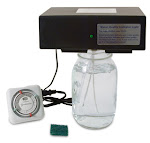Antimicrobial silver
is being used in more and more medical implants – such as in catheters, shunts,
and bone plates and screws – to help prevent post-surgical infection of the
implant site.
But is this practice safe? And does it result in a significant reduction
of post-surgical infection?
The good news is that based
on existing clinical data, silver-coated implants are not only safe, but they
do indeed dramatically reduce post-surgical infection.
The bad news is that
researchers have yet to figure out a way to more accurately control the release
of silver ions from the silver-coated implants.
This means there can be times when not enough silver ions to control
infection are being released, and times when more than enough ionic silver is
being released from the implant.
Researchers are now
looking at ways to more carefully control the amount of silver ions being
released from implants, so as to more effectively control the possibility of
infection. Here’s the story…
Hi, Steve Barwick here, for The Silver Edge…
According to this
website, silver is now used as an antimicrobial agent in numerous implant
technologies, including:
- Neuro-surgery shunts
- Urology catheters
- Orthopaedic implants
- Suturing material
- Bone plates and screws
Even bone cement is being mixed with silver to help prevent
infections (see clinical study overview, here)
after bone surgery.
What’s more, titanium plates coated with silver
nanoparticles are now being used in a variety of implants, and clinical studies
have demonstrated silver to be completely compatible with the body’s cells,
causing no cytotoxicity while dramatically reducing levels of pathogenic
microorganisms at the implant site. (See
clinical study overview, here.)
The idea being that implants coated with antimicrobial
silver will have far less chance of becoming repositories for colonies of
infection microbes such as those that can cause MRSA or other serious internal infections.
At present, at least 100,000 cases of internal infection
associated with medical implants – such as hip or knee joint replacements – are
reported every year, at a cost to the U.S. health care system of over $1.5
billion annually.
But a simple coating of silver on the medical implant can help
keep microbial contamination of the implant site to a bare minimum, resulting
in far fewer serious infections after implant surgery.
This helps prevent the need for drastic measures should a
surgical implant site become infected.
Without silver-coated implants, the only options are
long-term therapy with antibiotic drugs… surgical removal of the implant…debridement
of the infected tissue surrounding the implant…and implant replacement – all of
which carry serious dangers of their own.
More Advances Coming
But while silver-coated medical implants are proving to be
extremely helpful in preventing infection of the implant surgical site, they’re
not perfect.
That’s because infection prevention is completely dependent
upon the release of silver ions from the silver-coated implant. And that release of silver ions can be
inconsistent, depending upon the location of the implant, the person’s body
chemistry and a host of other factors.
For example, studies have demonstrated that more silver ions
are released naturally in the presence of acidic bodily fluids than in the
presence of alkaline bodily fluids. So
shifts in the acidity or alkalinity of bodily fluids can increase (or decrease)
the number of infection-fighting silver ions being released from a
silver-coated implant.
That’s why researchers such as Rohan Shirwaiker, Assistant Professor of Industrial and Systems Engineering at North Carolina State University and others like him are constantly looking for ways to utilize silver more effectively in medical implant technology.
That’s why researchers such as Rohan Shirwaiker, Assistant Professor of Industrial and Systems Engineering at North Carolina State University and others like him are constantly looking for ways to utilize silver more effectively in medical implant technology.
For example, according to this 2015 news
article titled “Silver Shines as Antibacterial for Medical Implants,” Professor
Shirwaiker reveals that he’s working on “engineering ways to apply
a low-intensity electrical charge to a silver-titanium orthopedic
implant.”
This technique would allow a silver-coated titanium implant
-- such as a hip or knee joint replacement -- to release on a constant and
controlled basis “silver ions that kill or neutralize bacteria on and around
the implant.”
In other words, it’s often not enough that a titanium hip or knee joint replacement is coated with antimicrobial silver in order to help prevent microbes from colonizing in or around the implant and creating pockets of infection.
There has to be a way to make sure the silver coating on the
implant releases enough silver ions to consistently
get the job of killing pathogens done, not just at the implant site, but in the
surrounding tissues as well.
After all, anytime silver is used on a medical implant, it’s
going to release silver ions as soon as acidic bodily fluids react with the
silver coating on the implant.
But this natural release of silver ions from the
silver-coated implant cannot be effectively controlled. Sometimes the release of silver ions is high
enough to kill all of the pathogens in the environment around the implant, and
sometimes it’s not, depending upon a variety of biological factors.
However, as Professor Shirwaiker’s research
is demonstrating, if a very tiny electrical charge – perhaps battery driven,
similar to the way a pacemaker works -- is applied to the silver-coated
implant, then the release of silver ions can be more effectively
controlled.
The challenge, of course, is to make sure that the tiny electrical
charge on the silver-coated implant does not release too much ionic silver into the surrounding area, resulting over
time in silver buildup or even potential toxicity to nearby healthy cells.
As Professor Shirwaiker points out, “One of the engineering challenges is to precisely control the level of silver that is released so that no healthy cells are compromised…”
As Professor Shirwaiker points out, “One of the engineering challenges is to precisely control the level of silver that is released so that no healthy cells are compromised…”
Basically, Professor Shirwaiker’s idea is that if infection
begins to show at the implant site in spite of the fact that the implant has
been silver-coated, then the power source delivering silver ions from the silver-coated
implant could be turned up by remote control so that more silver ions are
released until the threat of infection is abated. Then it can be turned back down.
Professor Shirwaiker looks forward to the time when such an
electrically based system controlling silver ion release from implants can be
incorporated into any type of surgical implant.
The Bottom Line
The bottom line is that silver-coated implant technology is
still in its early stages, and more is being learned all of the time as
researchers continue to study the technology and its benefits.
There’s no doubt that silver-treated implants work to help
prevent infection at the implant site.
The only factor researchers haven’t pinned down yet is the
ability to more effectively control the release of silver ions at the implant
site in order to make sure there’s enough silver present to prevent infection,
while not overloading the body’s tissues with silver which theoretically could
result in a case of localized argyria (i.e., tissue staining).
What Some People Are
Doing
Some people with simple medical implants, such as catheters,
are taking matters into their own hands and using colloidal silver in order to
prevent infections at the surgical site.
For example, on the Testimonials page of
TheSilverEdge.com website, one woman tells how she used colloidal silver to
help resolve her husband’s infections in an artificial bladder. Here’s what she wrote:
“In
1993 my husband had cancer of the urinary bladder and prostrate.
The
surgeons who performed the surgery to remove the cancer made an internal
artificial bladder from the ascending colon with a valve and an opening to the
bladder on the right side of his abdomen.
This
internal artificial bladder is called an Indiana Pouch. It has to be
catheterized every 4-6 hours to empty it.
For
the past 16 years there have been continuous infections in the Indiana Pouch
with my husband needing to take antibiotics for each infection. Maybe a week to
two weeks would be infection free. Every method of keeping the pouch clear of
bacteria, etc. has been tried. The bug in the pouch was E. coli.
At
times my husband was hospitalized with such severe infections needing to be
given antibiotics in his veins. After so many antibiotics the bacteria had
become resistant to almost all available drugs.
Colloidal
Silver to the rescue! My husband takes 1 tablespoon of 10 ppm twice a day by
mouth. I instill 2 ounces of colloidal silver into the pouch in the morning and
at bedtime. Thus the cure of the Indiana Pouch infections.
This
process has been used for months thereby eliminating the need for antibiotics.
We could never afford to buy the amount of colloidal silver that is used daily
to prevent infection of the pouch. Every three days I make two quarts of
colloidal silver for my husband’s use.
The
Micro-Particle Colloidal Silver Generator has been a life saver. It’s easy to
use, making a reliable amount of micro-particle silver at an economical cost.”
--
G.E., Jackson, LA
In another instance, a gentleman with a home dialysis tube
in his stomach contracted a peritoneal infection, and used oral doses of colloidal
silver to stop it:
"Steve, I read your emails all the time about ways to use Colloidal
Silver. Well, I thought I’d relate a way I’ve never seen before. I used it
starting last Friday evening.
I do what is called peritoneal dialysis. Some people might recognize it as ‘at home’ dialysis.
It involves having a tube placed in your abdomen and it penetrates the peritoneal lining of your belly region. It’s a very sterile place and prone to life threatening infections if it is compromised, as is the case with this type of dialysis.
You have a constant ‘hole’ in that lining making peritonitis very possible all the time. It can become very dangerous and even life threatening if not dealt with as soon as it’s diagnosed. I realized I had contracted peritonitis and the pain was easily a 9 on a scale of 1-10. It hurt to breathe!!
I began drinking 8 ounces of colloidal silver late Friday evening Saturday morning. Within 4 hours, the pain had dropped to a tolerable 3 out of 10! By Sunday, the pain was gone. I will continue using 8 ounces 3 times daily for two weeks to make sure the infection is gone.
Please, anyone reading this, I AM ONLY USING THIS AMOUNT DURING A TWO WEEK PERIOD FOR A SPECIAL REASON. It should NOT be used in this amount on a regular basis! Use the recommended amount.
The powerful antibiotic Vancomycin is usually what’s used for peritonitis, and my doctor says even then the infection is very difficult to kill! Colloidal Silver killed it without batting an eye!
So, colloidal silver can be used safely by those on dialysis, if they need to ward off infection!”
I use YOUR Micro-Particle Colloidal Silver Generator to make my colloidal silver, running it for 3 hours each time making 10 ppm batches.
Right now, I am running it once a day just about to keep up with how much I’m consuming, for obvious reasons. That will diminish back, once I’m done with my ‘course’ of taking it to make sure the infection is gone.
The way I see it, you have to take some, and it kills off millions, but there will still be some pathogens that survive. Then, they start growing again, so you have to do another dose, it kills a little more, then they start growing again, then you take another dose, and before you know it, they have lost the battle, but it does take perseverance!
I told my dialysis nurse today about my bout with peritonitis and she said, ‘Do we need to do a culture to make sure it’s gone?’
I told her what I did and how fast it worked. Within 4 hours the pain had all but disappeared, and within 2 days all of the pain was gone! She told me they have to give vancomycin to their patients for six weeks!!
I told her I was going to use the silver for two weeks to be sure it’s gone. She said it’s a possible alternative to some of her patients who won’t use vanc! Cool huh?
Hopefully my testimonial will help others become infection free.”
-- Randall F.
I do what is called peritoneal dialysis. Some people might recognize it as ‘at home’ dialysis.
It involves having a tube placed in your abdomen and it penetrates the peritoneal lining of your belly region. It’s a very sterile place and prone to life threatening infections if it is compromised, as is the case with this type of dialysis.
You have a constant ‘hole’ in that lining making peritonitis very possible all the time. It can become very dangerous and even life threatening if not dealt with as soon as it’s diagnosed. I realized I had contracted peritonitis and the pain was easily a 9 on a scale of 1-10. It hurt to breathe!!
I began drinking 8 ounces of colloidal silver late Friday evening Saturday morning. Within 4 hours, the pain had dropped to a tolerable 3 out of 10! By Sunday, the pain was gone. I will continue using 8 ounces 3 times daily for two weeks to make sure the infection is gone.
Please, anyone reading this, I AM ONLY USING THIS AMOUNT DURING A TWO WEEK PERIOD FOR A SPECIAL REASON. It should NOT be used in this amount on a regular basis! Use the recommended amount.
The powerful antibiotic Vancomycin is usually what’s used for peritonitis, and my doctor says even then the infection is very difficult to kill! Colloidal Silver killed it without batting an eye!
So, colloidal silver can be used safely by those on dialysis, if they need to ward off infection!”
I use YOUR Micro-Particle Colloidal Silver Generator to make my colloidal silver, running it for 3 hours each time making 10 ppm batches.
Right now, I am running it once a day just about to keep up with how much I’m consuming, for obvious reasons. That will diminish back, once I’m done with my ‘course’ of taking it to make sure the infection is gone.
The way I see it, you have to take some, and it kills off millions, but there will still be some pathogens that survive. Then, they start growing again, so you have to do another dose, it kills a little more, then they start growing again, then you take another dose, and before you know it, they have lost the battle, but it does take perseverance!
I told my dialysis nurse today about my bout with peritonitis and she said, ‘Do we need to do a culture to make sure it’s gone?’
I told her what I did and how fast it worked. Within 4 hours the pain had all but disappeared, and within 2 days all of the pain was gone! She told me they have to give vancomycin to their patients for six weeks!!
I told her I was going to use the silver for two weeks to be sure it’s gone. She said it’s a possible alternative to some of her patients who won’t use vanc! Cool huh?
Hopefully my testimonial will help others become infection free.”
-- Randall F.
Learn More…
If
you’re interested in learning how to make your own high-quality colloidal
silver at home, for less than 36 cents a
quart, here are some additional short articles you might want to take a
look at:
Meanwhile, I’ll be back next week with another great article on
colloidal silver….
Yours for the safe, sane and responsible
use of colloidal silver,
Steve Barwick, author
The Ultimate Colloidal Silver Manual
The Ultimate Colloidal Silver Manual
Helpful Links:
Important Note and
Disclaimer: The contents of this Ezine have not been
evaluated by the Food and Drug Administration.
Information conveyed herein is from sources deemed to be accurate and
reliable, but no guarantee can be made in regards to the accuracy and
reliability thereof. The author, Steve
Barwick, is a natural health journalist with over 30 years of experience
writing professionally about natural health topics. He is not
a doctor. Therefore, nothing stated in
this Ezine should be construed as prescriptive in nature, nor is any part of
this Ezine meant to be considered a substitute for professional medical
advice. Nothing reported herein is
intended to diagnose, treat, cure or prevent any disease. The author is simply reporting in
journalistic fashion what he has learned during the past 17 years of
journalistic research into colloidal silver and its usage. Therefore, the information and data presented
should be considered for informational purposes only, and approached with
caution. Readers should verify for
themselves, and to their own satisfaction, from other knowledgeable sources
such as their doctor, the accuracy and reliability of all reports, ideas,
conclusions, comments and opinions stated herein. All important health care decisions should be
made under the guidance and direction of a legitimate, knowledgeable and
experienced health care professional.
Readers are solely responsible for their choices. The author and publisher disclaim
responsibility and/or liability for any loss or hardship that may be incurred
as a result of the use or application of any information included in this
Ezine.
Copyright
2015 | Life & Health Research Group, LLC | PO Box 1239 | Peoria AZ
85380-1239 | All rights reserved.










No comments:
Post a Comment